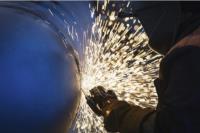 Add My Company
Add My Company
Sign In
The Most Important Types of Welding
30-03-2017

The first types of welding can be dated as far back as the Bronze and Iron Ages, when the art of forge welding was introduced to create various objects and structures found all around the world, such as the Iron Pillar of Delhi. After this, the Middle Ages was a time that saw advancements in forge welding, and it wasn’t until the early 19th century when the traditional form of welding was formed.
But what are the most important and/or the most common forms of welding?
Shielded Metal Arc Welding (SMAW)
This form of welding is also known as ‘stick welding’ or ‘electric welding’, and it is typically used to weld iron and various types of steel, such as carbon steel and stainless steel. The SMAW process uses a consumable electrode that has a chemical cleaning agent, also known in the industry as flux, surrounding it to protect the welding area.
The electrode is connected to a power supply which is then used to provide an electric current to the electrode. When the electrode is in contact, or very close, to the metal, an electric arc is formed, which then melts then metal and forms the weld.
Gas Tungsten Arc Welding (GTAW)
This is also known as tungsten inert gas, or TIG, welding, and it uses a non-consumable electrode made from tungsten that produces the weld. An inert gas such as helium or argon protects the weld area to protect the weld area from contamination due to the surrounding air.
The GTAW process is commonly used to weld thin pieces of stainless steel and non-ferrous metals such as aluminium, copper, and nickel. Because the electrode isn’t consumable, it provides the welder with greater control over the welding area, meaning the weld itself will be stronger compared to SMAW welds.
Gas Metal Arc Welding (GMAW)
This is also known as metal inert gas (MIG) or metal active gas (MAG) welding, and it combines two important features of the SMAW and GTAW processes. GMAW is a process that uses a consumable wire electrode to produce the electric arc and produce the necessary weld. A shielding gas is also fed through the welding gun, which protects the weld from contamination.
The shielding gas used to be an inert gas like helium or argon, however, this proved to be costly, which meant that this method was used sparingly. However, it wasn’t long until scientists started using semi-inert gases such as carbon dioxide to do the same job but at a much cheaper cost.
Flux-Cored Arc Welding (FCAW)
This form of welding is practically identical to the GMAW process, but the only difference is that the wire is instead a tubular wire that is filled with flux. An externally applied shielding gas is sometimes used, but it depends entirely on the flux; if the flux can provide the necessary protection against atmospheric contamination, then the shielding gas isn’t required.
These are some of the most common forms of welding in the present day, but there are many other forms that we haven’t talked about, so make sure to check out the blog for future information of these additional processes!
We at Adams Gas provide the very best shielding gases for your GTAW and GMAW needs; whether you are a hobbyist or an industrial engineer that requires shielding gas, we are more than happy to help.
For more information on The Most Important Types of Welding talk to Adams Gas
Enquire Now
List your company on FindTheNeedle.

